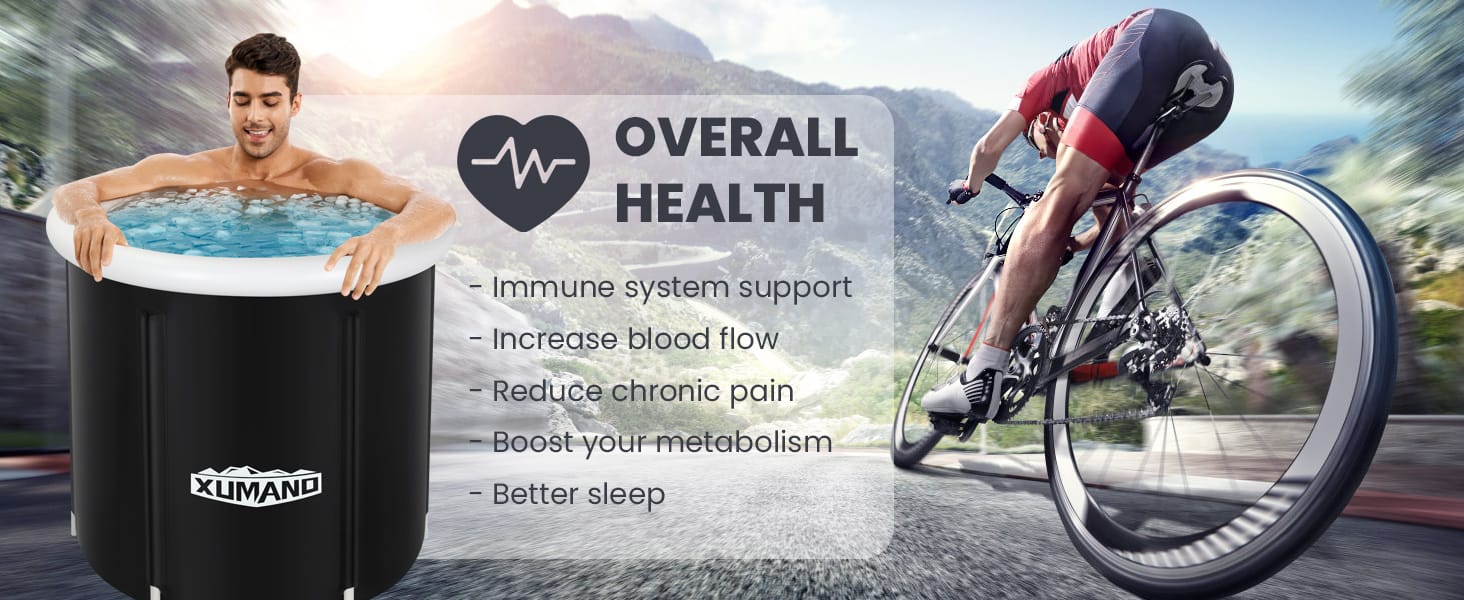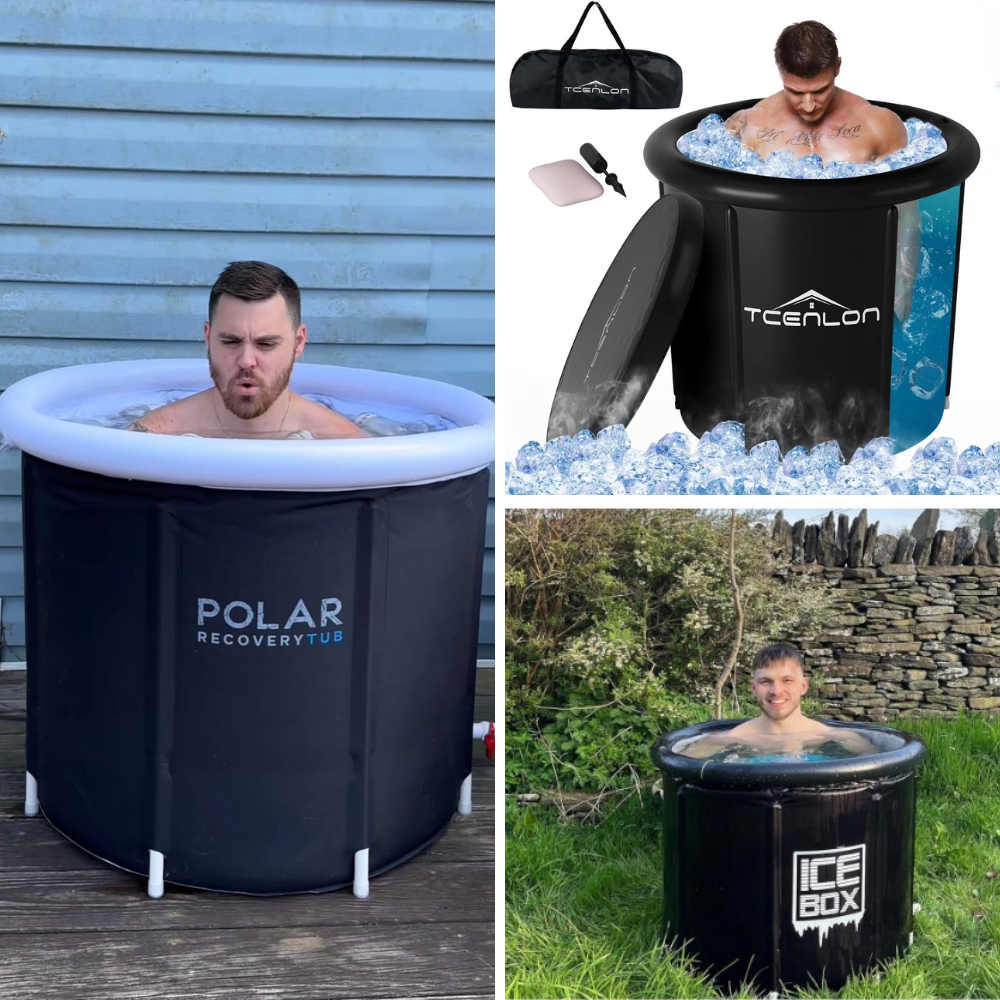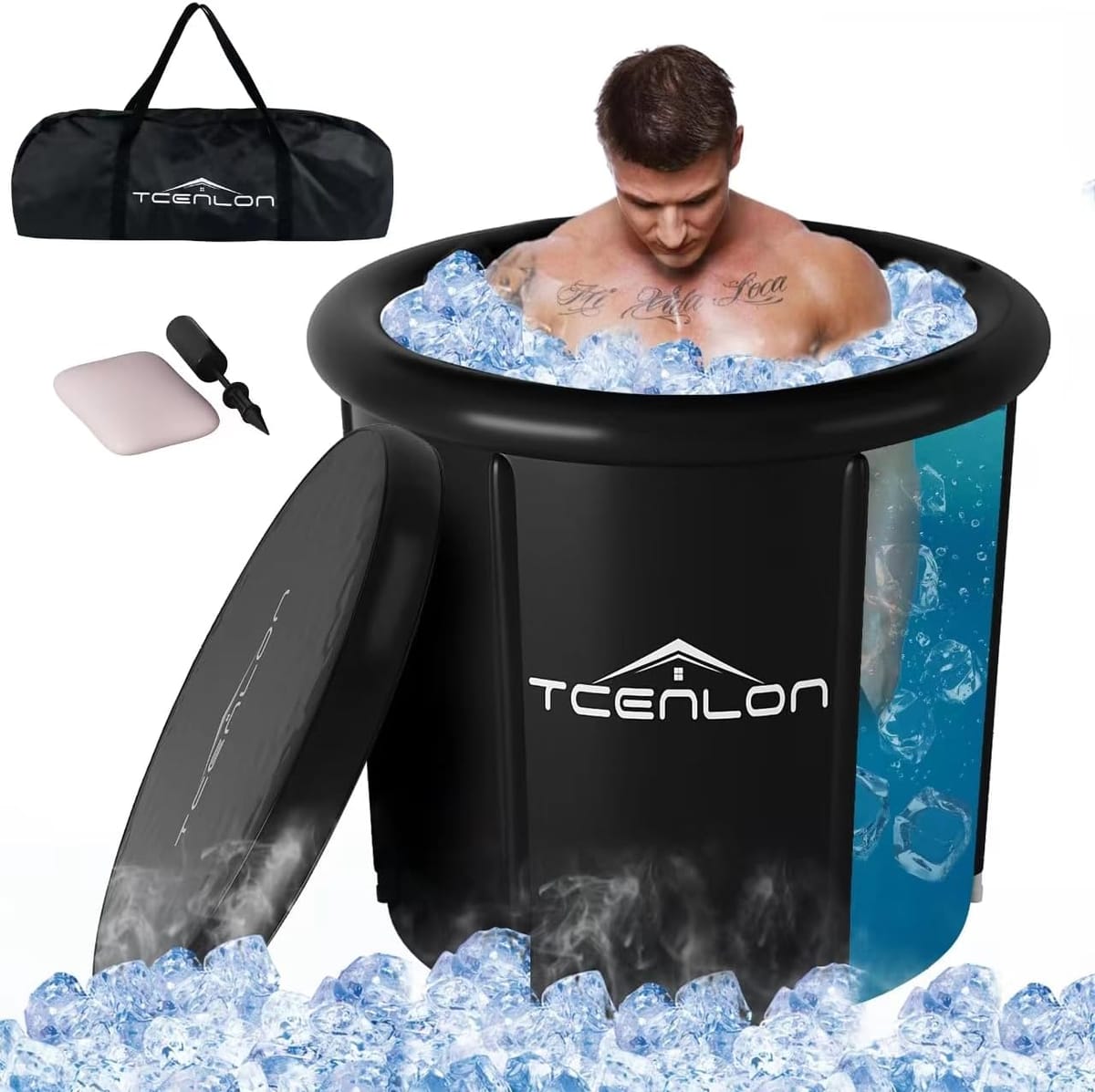Key Takeaways:
- Optimal Duration: The ideal time to stay in an ice bath ranges from 10 to 15 minutes.
- Health Benefits: Ice baths can help reduce inflammation, and muscle soreness, and improve recovery.
- Precautions: Always consult a healthcare professional before starting cold water therapy, especially if you have underlying health conditions.
Introduction
Ice baths, also known as cold water immersion therapy, have been a staple in athletic training and physical therapy for decades. Cold therapy, which includes ice baths, has historical significance and is known for its potential benefits for both physical and mental well-being. This ancient practice involves immersing the body in very cold temperatures to aid in muscle recovery and reduce inflammation. But how long should you stay in an ice bath to reap the potential benefits without risking health concerns? This comprehensive guide will delve into the optimal duration, potential benefits, and precautions you should take when considering an ice bath.
The Science Behind Ice Baths
Ice baths work by constricting blood vessels and reducing blood flow to the muscles, which helps decrease inflammation and muscle soreness. When you step into freezing water, your body responds by sending nutrient-rich blood to major organs, aiding in recovery. The hydrostatic pressure from the cold water also helps reduce swelling and flush out lactic acid, a byproduct of muscle fatigue.
Cold water therapy methods have been used for centuries, from ancient Roman baths to modern athletic training. The practice has evolved, but the underlying principles remain the same: using cold exposure to promote healing and recovery. Understanding the science behind ice baths can help you make informed decisions about how long to stay in an ice bath.
Optimal Duration for Ice Baths
The optimal duration for an ice bath varies depending on individual tolerance and specific goals. It is crucial to stay hydrated and listen to your body during an ice bath session. Generally, experts recommend staying in an ice bath for 10 to 15 minutes. This time frame is sufficient to achieve the desired temperature effects on the body without risking prolonged exposure to extreme cold.
Staying in an ice bath for longer than 15 minutes can lead to potential risks such as nerve damage and decreased muscle strength. It’s essential to listen to your body and consult a healthcare provider to determine the appropriate duration for your needs. Always start with shorter sessions and gradually increase the time spent in the ice bath as your body adapts.
Benefits of Ice Baths
Ice baths offer a range of potential health benefits, including reduced muscle soreness, decreased inflammation, and improved muscle recovery. Cold water immersion therapy can also enhance blood flow and nutrient delivery to muscles, aiding in injury recovery and overall physical performance.
Cold showers, as an alternative to ice baths, can also help reduce inflammation and improve recovery.
In addition to physical benefits, taking ice baths can improve mental resilience and better sleep. The extreme cold triggers the release of endorphins, which can elevate mood and reduce stress. Regular cold exposure can also help regulate body temperature and improve sleep quality.
Precautions and Risks
While ice baths can offer numerous benefits, they are not without risks. Prolonged exposure to very cold temperatures can lead to hypothermia, nerve damage, and other health concerns. Similarly, prolonged exposure to cold air, such as in whole-body cryotherapy, can pose risks and should be approached with caution. It’s crucial to consult a healthcare professional before starting cold water therapy, especially if you have underlying medical conditions.
Always monitor your body temperature and avoid staying in the ice bath for too long. If you experience numbness, tingling, or extreme discomfort, exit the ice bath immediately. Gradually warm your body with a warm towel or hot water immersion to prevent shock to your system.
How to Prepare for an Ice Bath

Preparing for an ice bath involves more than simply filling a tub with ice water. Start by ensuring the water temperature is between 50 to 59 degrees Fahrenheit. Add ice gradually to achieve the desired temperature, and use a thermometer to monitor the water temperature accurately.
Before taking an ice bath, perform light stretching or a warm-up to increase blood flow to your muscles. This can help reduce the shock of cold exposure and make the experience more tolerable. Have a warm towel or blanket nearby to wrap yourself in after the ice bath.
Breathing Techniques During Ice Baths
Breathing exercises can help you manage the discomfort of cold exposure and enhance the benefits of an ice bath. Practice deep, controlled breathing to calm your nervous system and maintain a steady heart rate. Focus on inhaling deeply through your nose and exhaling slowly through your mouth.
Controlled breathing can also help you stay in the ice bath for the recommended duration. By focusing on your breath, you can distract yourself from the cold and maintain a sense of calm. This technique is particularly useful for those new to cold water immersion therapy.
Post-Ice Bath Recovery
After an ice bath, it's essential to warm your body gradually. Avoid jumping into a hot shower immediately, as this can cause a sudden shift in blood flow and lead to dizziness or fainting. Instead, wrap yourself in a warm towel or blanket and sip on a warm beverage.
Engage in light stretching or gentle movement to promote blood flow and aid in muscle recovery. This can help flush out any remaining lactic acid and reduce muscle stiffness. Hydrate well to replenish fluids lost during the ice bath and support overall recovery.
Ice Bath Tips for Beginners
If you’re new to ice baths start with shorter sessions of 5 to 10 minutes and gradually increase the duration as your body adapts. Begin with a cold shower to acclimate to cold water therapy before progressing to ice baths. Use a thermometer to monitor the water temperature and ensure it stays within the recommended range of 50 to 59 degrees Fahrenheit.
Consider using contrast water therapy, alternating between cold and hot water immersion, to ease into the practice. This method can help your body adjust to the cold and provide additional benefits for muscle recovery and blood flow.
Ice Baths for Athletic Training
Athletes often use ice baths as part of their training regimen to reduce muscle soreness and enhance recovery. Cold water immersion therapy can help athletes recover faster between workouts and improve overall performance. The practice is particularly beneficial after intense training sessions or competitions.
Incorporating ice baths into your training routine can help you stay on top of your game and prevent injuries. Consult with a coach or healthcare provider to determine the best approach for your specific needs and goals.
Ice Baths for Injury Recovery
Ice baths can be an effective tool for injury recovery, helping to reduce inflammation and promote healing. Cold water immersion therapy can aid in the recovery of muscle strains, sprains, and other soft tissue injuries. Cold exposure helps constrict blood vessels, reducing swelling and pain.
Always consult a healthcare professional before using ice baths for injury recovery. They can provide guidance on the appropriate duration and frequency of ice baths based on your specific injury and overall health.
Ice Baths for Mental Resilience
Taking ice baths can also improve mental resilience by challenging your body and mind to endure extreme cold. The practice can help build mental toughness and enhance your ability to handle stress and discomfort. Regular cold exposure can also boost mood and reduce anxiety.
Incorporating ice baths into your routine can provide both physical and mental benefits, helping you build resilience and improve overall well-being. Start with shorter sessions and gradually increase the duration as you become more comfortable with the practice.
Ice Baths and Blood Pressure
Cold water immersion therapy can have an impact on blood pressure, causing it to rise temporarily during the ice bath. This response is due to the constriction of blood vessels and the body's effort to maintain core temperature. While this effect is generally temporary, it's essential to monitor your blood pressure if you have underlying health conditions.
Consult a healthcare provider before starting ice baths if you have concerns about blood pressure or other cardiovascular issues. They can provide personalized recommendations and ensure the practice is safe for you.
Ice Baths and Muscle Recovery
Ice baths are widely used for muscle recovery, helping to reduce muscle soreness and speed up the healing process. The cold exposure helps flush out lactic acid and reduce inflammation, allowing muscles to recover more quickly after intense exercise.
Incorporating ice baths into your recovery routine can help you stay on track with your training and prevent muscle fatigue. Always follow recommended guidelines for duration and temperature to maximize the benefits and minimize risks.
Ice Baths and Sleep Quality
Taking ice baths can also improve sleep quality by regulating body temperature and promoting relaxation. The cold exposure triggers the release of endorphins, which can help you feel more relaxed and improve overall sleep patterns.
Consider taking an ice bath in the evening to help wind down and prepare for a restful night's sleep. Ensure the water temperature is within the recommended range and limit the duration to avoid prolonged exposure to extreme cold.
Ice Baths and Inflammation
One of the primary benefits of ice baths is their ability to reduce inflammation. Cold water immersion therapy helps constrict blood vessels and reduce blood flow to inflamed areas, decreasing swelling and pain. This effect can be particularly beneficial for athletes and individuals recovering from injuries.
Incorporating ice baths into your routine can help manage inflammation and support overall recovery. Always consult a healthcare professional before starting cold water therapy, especially if you have underlying health conditions.
Ice Baths and Athletic Performance
Ice baths can enhance athletic performance by reducing muscle soreness and improving recovery times. Cold water immersion therapy helps flush out lactic acid and reduce inflammation, allowing athletes to train harder and recover faster.
Incorporating ice baths into your training regimen can help you stay on top of your game and prevent injuries. Consult with a coach or healthcare provider to determine the best approach for your specific needs and goals.
Ice Baths and Mental Health
Taking ice baths can also have positive effects on mental health by reducing stress and anxiety. The cold exposure triggers the release of endorphins, which can elevate mood and promote relaxation. Regular cold exposure can also help build mental resilience and improve overall well-being.
Incorporating ice baths into your routine can provide both physical and mental benefits, helping you build resilience and improve overall well-being. Start with shorter sessions and gradually increase the duration as you become more comfortable with the practice.
Ice Baths and Blood Flow
Cold water immersion therapy can enhance blood flow by constricting blood vessels and promoting circulation. The cold exposure helps flush out lactic acid and reduce inflammation, allowing muscles to recover more quickly after intense exercise.
Incorporating ice baths into your recovery routine can help you stay on track with your training and prevent muscle fatigue. Always follow recommended guidelines for duration and temperature to maximize the benefits and minimize risks.
Ice Baths and Muscle Soreness
Ice baths are widely used for muscle soreness, helping to reduce pain and speed up the healing process. The cold exposure helps flush out lactic acid and reduce inflammation, allowing muscles to recover more quickly after intense exercise.
Incorporating ice baths into your recovery routine can help you stay on track with your training and prevent muscle fatigue. Always follow recommended guidelines for duration and temperature to maximize the benefits and minimize risks.
Ice Baths and Injury Prevention
Taking ice baths can also help prevent injuries by reducing muscle soreness and improving recovery times. Cold water immersion therapy helps flush out lactic acid and reduce inflammation, allowing muscles to recover more quickly after intense exercise.
Incorporating ice baths into your training regimen can help you stay on top of your game and prevent injuries. Consult with a coach or healthcare provider to determine the best approach for your specific needs and goals.
Ice Baths and Muscle Strength

Ice baths can also help improve muscle strength by reducing muscle soreness and speeding up the healing process. The cold exposure helps flush out lactic acid and reduce inflammation, allowing muscles to recover more quickly after intense exercise.
Incorporating ice baths into your recovery routine can help you stay on track with your training and prevent muscle fatigue. Always follow recommended guidelines for duration and temperature to maximize the benefits and minimize risks.
Ice Baths and Physical Therapy
Ice baths are widely used in physical therapy to recover injuries and reduce inflammation. Cold water immersion therapy helps constrict blood vessels and reduce blood flow to inflamed areas, decreasing swelling and pain. This effect can be particularly beneficial for individuals recovering from injuries.
Incorporating ice baths into your physical therapy routine can help manage inflammation and support overall recovery. Always consult a healthcare professional before starting cold water therapy, especially if you have underlying health conditions.
Ice Baths and Contrast Water Therapy
Contrast water therapy, alternating between cold and hot water immersion, can provide additional benefits for muscle recovery and blood flow. This method helps your body adjust to the cold and provides a more balanced approach to recovery.
Incorporating contrast water therapy into your routine can help you stay on track with your training and prevent muscle fatigue. Always follow recommended guidelines for duration and temperature to maximize the benefits and minimize risks.
Ice Baths and Hydrostatic Pressure
The hydrostatic pressure from cold water immersion therapy can help reduce swelling and flush out lactic acid, aiding in muscle recovery. This effect can be particularly beneficial for athletes and individuals recovering from injuries.
Incorporating ice baths into your recovery routine can help you stay on track with your training and prevent muscle fatigue. Always follow recommended guidelines for duration and temperature to maximize the benefits and minimize risks.
Ice Baths and Nutrient-Rich Blood
Cold water immersion therapy can enhance blood flow and nutrient delivery to muscles, aiding in injury recovery and overall physical performance. The cold exposure helps flush out lactic acid and reduce inflammation, allowing muscles to recover more quickly after intense exercise.
Incorporating ice baths into your recovery routine can help you stay on track with your training and prevent muscle fatigue. Always follow recommended guidelines for duration and temperature to maximize the benefits and minimize risks.
Ice Baths and Muscle Fatigue
Ice baths are widely used for muscle fatigue, helping to reduce pain and speed up the healing process. The cold exposure helps flush out lactic acid and reduce inflammation, allowing muscles to recover more quickly after intense exercise.
Incorporating ice baths into your recovery routine can help you stay on track with your training and prevent muscle fatigue. Always follow recommended guidelines for duration and temperature to maximize the benefits and minimize risks.
Ice Baths and Athletic Training
Athletes often use ice baths as part of their training regimen to reduce muscle soreness and enhance recovery. Cold water immersion therapy can help athletes recover faster between workouts and improve overall performance. The practice is particularly beneficial after intense training sessions or competitions.
Incorporating ice baths into your training routine can help you stay on top of your game and prevent injuries. Consult with a coach or healthcare provider to determine the best approach for your specific needs and goals.
Ice Baths and Muscle Damage
Ice baths can be an effective tool for managing muscle damage, helping to reduce inflammation and promote healing. Cold water immersion therapy can aid in the recovery of muscle strains, sprains, and other soft tissue injuries. Cold exposure helps constrict blood vessels, reducing swelling and pain.
Always consult a healthcare professional before using ice baths for injury recovery. They can provide guidance on the appropriate duration and frequency of ice baths based on your specific injury and overall health.
Ice Baths and Medical Conditions
If you have underlying medical conditions, it's essential to consult a healthcare professional before starting ice baths. Cold water immersion therapy can have an impact on blood pressure, circulation, and overall health. A healthcare provider can provide personalized recommendations and ensure the practice is safe for you.
Always monitor your body temperature and avoid staying in the ice bath for too long. If you experience numbness, tingling, or extreme discomfort, exit the ice bath immediately. Gradually warm your body with a warm towel or hot water immersion to prevent shock to your system.


How often should I take an ice bath?
The frequency of ice baths can vary depending on your training intensity and recovery needs. Generally, 2-3 times per week is sufficient for most individuals. However, consult a healthcare professional to determine the best frequency for your specific needs.
Can ice baths help with weight loss?
While ice baths alone won't lead to significant weight loss, they can support your weight loss efforts by boosting your metabolism. Combine ice baths with a balanced diet and regular exercise for the best results.
Are there any risks associated with ice baths?
Yes, prolonged exposure to freezing water can lead to hypothermia, nerve damage, and other health concerns. Always consult a healthcare provider before starting cold water therapy and monitor your body temperature to avoid potential risks.

Ice baths can offer numerous benefits, including reduced muscle soreness, decreased inflammation, and improved recovery. The optimal duration for an ice bath is generally 10 to 15 minutes, but this can vary depending on individual tolerance and specific goals. Always consult a healthcare professional before starting cold water therapy, especially if you have underlying health conditions. By following recommended guidelines and listening to your body, you can safely incorporate ice baths into your recovery routine and enjoy the potential benefits.










